The Three Pyramids Spread
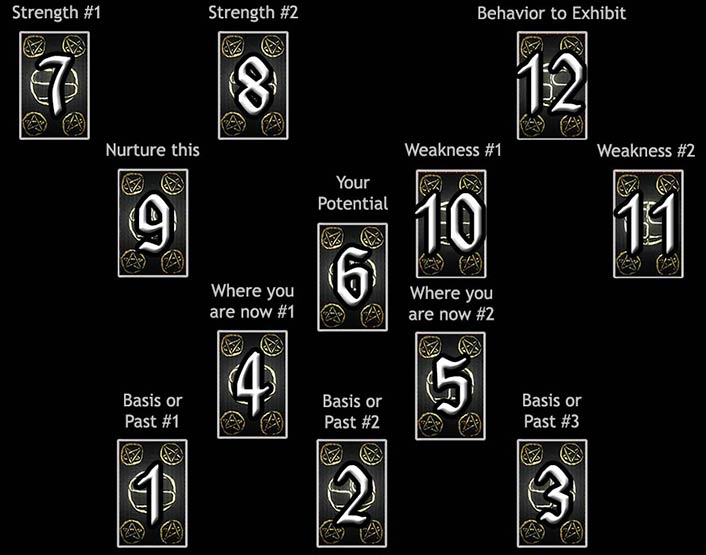
Difficulty: Complicated
Basically, there is the main pyramid in the centre, and two smaller pyramids on each side. One is inverted.
Positions 1 & 3 represent where the reader comes from, or what has made them/shaped them on the various levels. Can be from environment, upbringing, schooling, etc. A look at the past, but with more objectivity than is usually given when using tarot cards.
Positions 4 & 5 represent who the reader is right now. May or may not make pleasant reading, but hey, this is what this is about, right?
Position 6 represents who the reader could be. Again, it might or might not look good, but a person can learn from that and change who they are accordingly. (This is a bit like how Scrooge did things in 'A Christmas Carol'.)
Positions 7 & 8 are the reader's strengths. This is the light they have, which can be bought to the forefront. What carries the person should not be hidden or unacknowledged.
Position 9 represents what should be given to oneself or created within.
Position 10 & 11 represent personal areas for development or weaknesses. Again, might not make good reading, but if someone looks at their strengths first, they will be able to see a balance is there and can choose to focus on one side or the other. This is where a person could really see how their shadow side comes into play.
Position 12 represents what the reader should be offering externally, or what they can bring to their world or to others who inhabit that world.
Your Three Pyramids Reading
Strength #1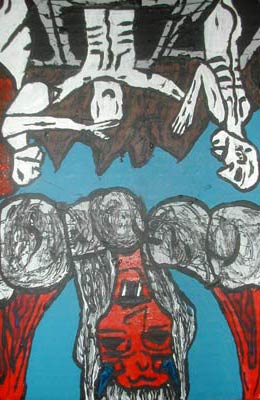 |
Strength #2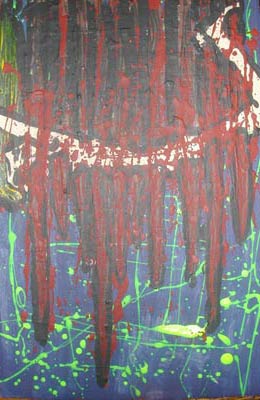 |
 |
Exhibit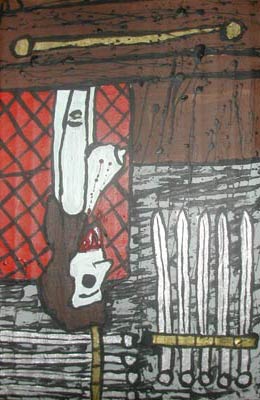 |
|||
Nurture This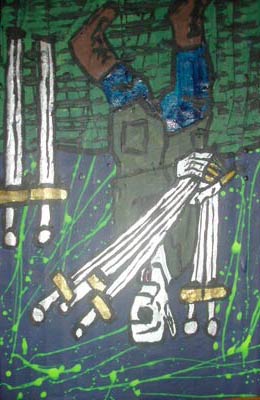 |
Potential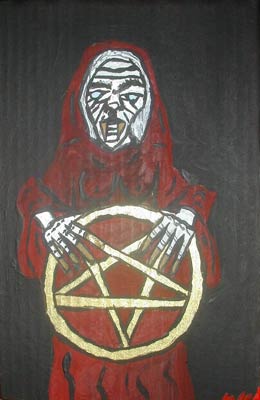 |
Infirmity #1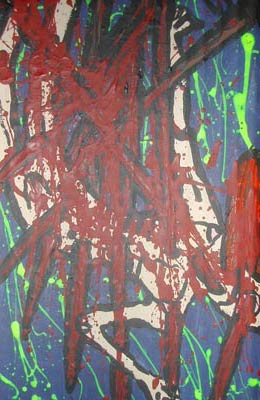 |
Infirmity #2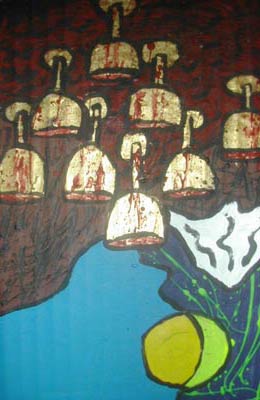 |
|||
Now #1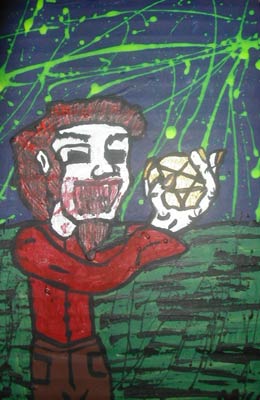 |
Now #2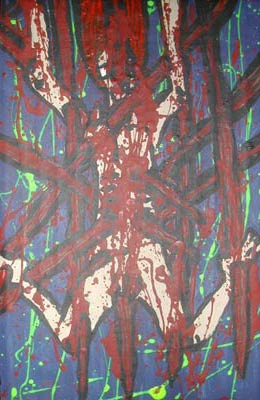 |
|||||
Base (past) #1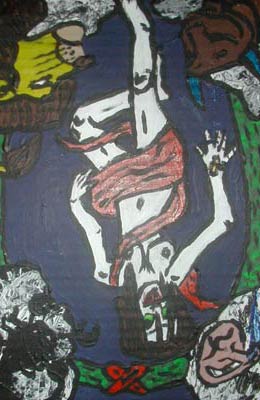 |
Base (past) #2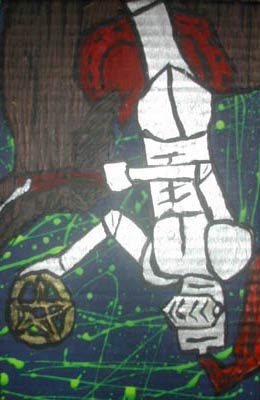 |
Base (past) #3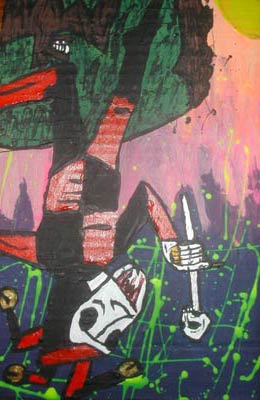 |
1: Base #1

Reversed
Symbolism:
The World depicts a powerful figure standing within a glowing circle of blood-red roses, symbolizing completion and unity. The four corners of the card feature elemental creatures: a bat, a wolf, a raven, and a serpent, representing balance and harmony among all forces. A starry night sky stretches infinitely behind the figure, while they hold a silver orb and a golden key, symbolizing mastery and fulfillment.
Meaning:
The World represents completion, fulfillment, and the achievement of long-term goals. It signifies harmony, wholeness, and the realization of your place in the greater tapestry of existence. This card often marks the end of a significant journey, celebrating your success and inviting you to share your gifts with others.
Reversed, the World suggests delays, unfinished business, or feelings of incompleteness. It may indicate the need to tie up loose ends before moving forward.
Keywords:
Reversed: Delays, lack of closure, incompletion, stagnation, unfinished business, imbalance.
2: Base #2

Reversed
Symbolism:
A knight bearing a pentagram signals the arrival of important news, symbolizing responsibility, discipline, and service. His steady demeanor suggests that success is achieved through diligent work and careful planning.
Meaning:
The Knight of Pentagrams represents service, responsibility, and a strong work ethic. It suggests that you are in a position to fulfill your obligations and take care of important matters. This card encourages patience and diligence in your endeavors.
Reversed, it points to laziness, stagnation, or a lack of progress. It may indicate that you are avoiding responsibilities or failing to take action in a timely manner.
Keywords:
Reversed: Laziness, stagnation, procrastination, neglect of duty.
3: Base #3

Reversed
Symbolism:
The Fool is depicted as a pale, ethereal figure walking a misty, crumbling path, a bundle tied to a staff slung over their shoulder. They gaze skyward, unaware of the jagged cliff at their feet. A spectral wolf follows close behind, snarling a silent warning. Overhead, a full moon illuminates their journey, hinting at the mystery and potential of new beginnings. In their hand, a delicate white rose symbolizes innocence and purity.
Meaning:
The Fool represents beginnings, spontaneity, and boundless potential. It urges you to take a leap of faith, trusting in the journey ahead. While the path may be uncertain, embracing the unknown opens the door to growth, discovery, and self-expression.
Reversed, the Fool warns of recklessness, naivety, or hesitation. It suggests the need to pause and consider potential consequences before plunging ahead.
Keywords:
Reversed: Recklessness, foolishness, naivety, hesitation, fear of the unknown, poor judgment.
4: Where you are now #1

Symbolism:
A young man clasps a pentagram, recognizing that he holds the power to shape his own destiny. This card represents potential and the beginning of a journey towards material or intellectual success.
Meaning:
The Page of Pentagrams signifies learning, new beginnings, and opportunities to grow. It points to a time when you are focused on laying the groundwork for future success. This card encourages you to be practical and take small, deliberate steps toward your goals.
Keywords:
Upright: Learning, potential, opportunities, practicality, new beginnings.
5: Where you are now #2

Reversed
Symbolism:
A grotesque figure hangs upside down, pierced by nine stakes in a horrific display of defiance and suffering. The unsettling scene illustrates the resilience required to endure opposition and remain steadfast in the face of challenges.
Meaning:
The Nine of Stakes is a card of resilience and strength under pressure. It symbolizes the final push before success, encouraging you to persevere despite fatigue or hardship. This card warns of challenges but assures you that your determination will see you through.
Reversed, the card signals obstacles, delays, or setbacks. It may also indicate a need for rest or recovery before resuming the fight.
Keywords:
Reversed: Setbacks, fatigue, delays, obstacles, vulnerability.
6: Your potential

Symbolism:
An older woman bears a large pentagram, symbolizing wisdom, wealth, and self-awareness. She exudes authority and grace, with a deep connection to both material success and personal power.
Meaning:
The Queen of Pentagrams embodies wealth, wisdom, and self-sufficiency. She suggests that you have reached a level of maturity where you can balance both material success and personal fulfillment. This card highlights nurturing, practicality, and the importance of enjoying the fruits of your labor.
Keywords:
Upright: Wisdom, wealth, self-sufficiency, authority, practicality.
7: Strength #1

Reversed
Symbolism:
Judgment depicts a haunting scene of the dead rising from crypts bathed in an eerie, silvery glow. A vampire angel hovers above, blowing a trumpet, its sound visible as luminous, curling waves. The figures below lift their arms skyward, drawn by the call to awakening. A massive, ancient tree stands in the background, its roots tangled with bones, symbolizing the cyclical nature of life and death.
Meaning:
Judgment signifies renewal, self-assessment, and a call to rise above the past. It asks you to confront your actions, choices, and truths, encouraging accountability and forgiveness. This card often appears during moments of profound transition, marking the opportunity to shed old burdens and embrace a higher purpose.
Reversed, Judgment warns of self-doubt, avoidance, or fear of change. It suggests a resistance to growth or ignoring the need for reflection.
Keywords:
Reversed: Self-doubt, avoidance, fear of change, lack of reflection, denial, stagnation.
8: Strength #2

Reversed
Symbolism:
Amidst a sea of blood and carnage, a corpse is barely discernible, overshadowed by the horror of the scene. The sheer brutality suggests the weight of betrayal, excessive burdens, or a struggle too great to bear.
Meaning:
The Ten of Stakes signifies the culmination of challenges and the weight of responsibilities. It warns of being overburdened or taking on too much. This card serves as a reminder to reassess priorities and delegate tasks when necessary. While it reflects exhaustion, it also suggests that an end to the struggle is near.
Reversed, the card warns of oppression, excessive force, or bad luck. It may also indicate that you are holding on to burdens that could be released.
Keywords:
Reversed: Oppression, brutality, bad luck, overextension, relief.
9: Nurture this

Reversed
Symbolism:
A cunning thief is shown stealing five of seven swords, his movements calculated and deliberate. He takes only what he can carry, leaving just enough behind to avoid detection. This image portrays strategy, cleverness, and moral ambiguity, reflecting the complexity of navigating difficult situations.
Meaning:
The Seven of Swords represents strategy, cunning, and the courage to take calculated risks. It suggests that bold action may be necessary to achieve your goals, even if it challenges conventional ethics. The card also highlights the importance of discretion and planning in overcoming obstacles.
Reversed, the Seven of Swords warns of dangerous plans that may fail or expose you to harm. It can indicate quarrels, deceit, or gossip that undermines trust. This card urges caution and vigilance in the face of potential betrayal or missteps.
Keywords:
Reversed: Failure, exposure, betrayal, quarrels, gossip, danger.
10: Weakness #1

Reversed
Symbolism:
A woman impaled by stakes showcases the cruel extremes of humanity. The stakes, angled as if in motion, represent swiftness and urgency. The scene hints at a world in constant flux, with events moving at an uncontrollable pace.
Meaning:
The Eight of Stakes represents rapid movement, action, and the culmination of efforts. It suggests that things are falling into place, and progress is accelerating toward your goals. This card encourages you to stay focused and prepared for opportunities that arise swiftly. It may also indicate travel, communication, or the arrival of significant news.
Reversed, the card points to inner turmoil, quarrels, or jealousy disrupting progress. It may also indicate delays or an inability to move forward due to unresolved issues.
Keywords:
Reversed: Delays, jealousy, conflict, stasis, miscommunication.
11: Weakness #2

Reversed
Symbolism:
Eight cups filled with life-giving sustenance fuel the party at dusk, urging the participants to break through to a new experience. The card reflects the need for a transformative journey.
Meaning:
The Eight of Cups signals a turning point, where something needs to be left behind in order to move toward new emotional growth. It often signifies the need to leave behind past emotional attachments to make room for new experiences. It can also point to personal growth and a desire to transcend superficial satisfaction.
Reversed, it suggests a period of emotional abundance, joy, and fulfillment. It may also represent staying in a comfort zone when it's time to move forward.
Keywords:
Reversed: Abundance, contentment, staying in comfort, fulfillment, joy.
12: Behavior to exhibit

Reversed
Symbolism:
Nine swords hang ominously on the wall, their sharp edges glinting faintly in the dim light. Below, a female vampire clutches her chest, overwhelmed by anxiety. Her surroundings are fortified excessively, reflecting her insecurities and fears of vulnerability. The scene captures a suffocating sense of dread and the heavy toll of mental anguish.
Meaning:
The Nine of Swords represents anxiety, fear, and despair. It signifies sleepless nights, obsessive thoughts, and the burden of worries that may or may not be grounded in reality. This card calls attention to the self-inflicted nature of some fears, urging reflection and perspective.
Reversed, the Nine of Swords suggests release from these burdens or the ability to confront and process your fears. It can also indicate being trapped by negativity or the lingering effects of past trauma that remain unresolved.
Keywords:
Reversed: Emotional release, recovery, clarity, lingering negativity, shame.
